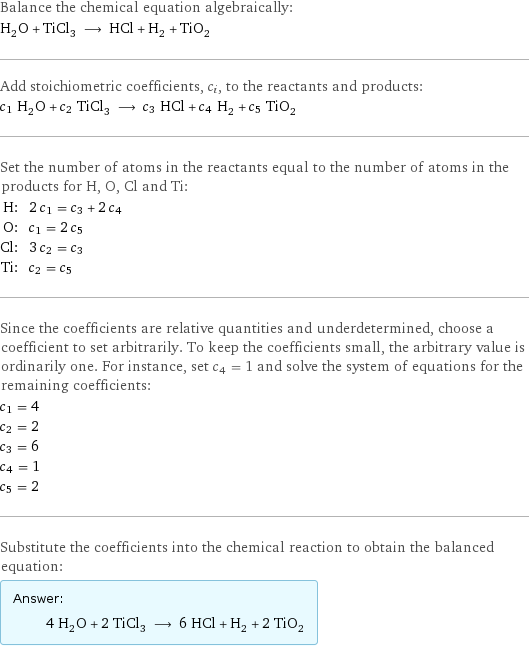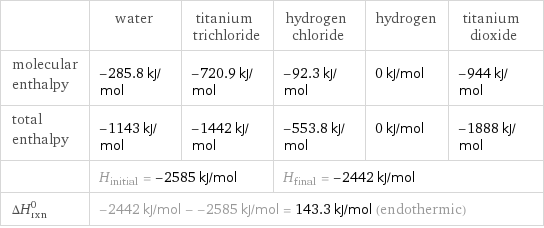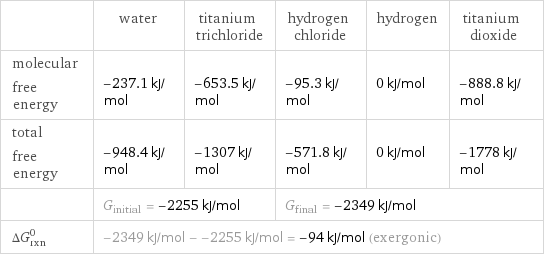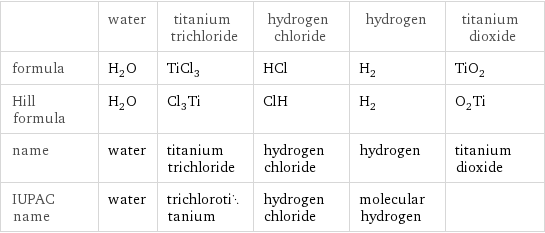Input interpretation

H_2O water + TiCl_3 titanium trichloride ⟶ HCl hydrogen chloride + H_2 hydrogen + TiO_2 titanium dioxide
Balanced equation

Balance the chemical equation algebraically: H_2O + TiCl_3 ⟶ HCl + H_2 + TiO_2 Add stoichiometric coefficients, c_i, to the reactants and products: c_1 H_2O + c_2 TiCl_3 ⟶ c_3 HCl + c_4 H_2 + c_5 TiO_2 Set the number of atoms in the reactants equal to the number of atoms in the products for H, O, Cl and Ti: H: | 2 c_1 = c_3 + 2 c_4 O: | c_1 = 2 c_5 Cl: | 3 c_2 = c_3 Ti: | c_2 = c_5 Since the coefficients are relative quantities and underdetermined, choose a coefficient to set arbitrarily. To keep the coefficients small, the arbitrary value is ordinarily one. For instance, set c_4 = 1 and solve the system of equations for the remaining coefficients: c_1 = 4 c_2 = 2 c_3 = 6 c_4 = 1 c_5 = 2 Substitute the coefficients into the chemical reaction to obtain the balanced equation: Answer: | | 4 H_2O + 2 TiCl_3 ⟶ 6 HCl + H_2 + 2 TiO_2
Structures

+ ⟶ + +
Names

water + titanium trichloride ⟶ hydrogen chloride + hydrogen + titanium dioxide
Reaction thermodynamics
Enthalpy

| water | titanium trichloride | hydrogen chloride | hydrogen | titanium dioxide molecular enthalpy | -285.8 kJ/mol | -720.9 kJ/mol | -92.3 kJ/mol | 0 kJ/mol | -944 kJ/mol total enthalpy | -1143 kJ/mol | -1442 kJ/mol | -553.8 kJ/mol | 0 kJ/mol | -1888 kJ/mol | H_initial = -2585 kJ/mol | | H_final = -2442 kJ/mol | | ΔH_rxn^0 | -2442 kJ/mol - -2585 kJ/mol = 143.3 kJ/mol (endothermic) | | | |
Gibbs free energy

| water | titanium trichloride | hydrogen chloride | hydrogen | titanium dioxide molecular free energy | -237.1 kJ/mol | -653.5 kJ/mol | -95.3 kJ/mol | 0 kJ/mol | -888.8 kJ/mol total free energy | -948.4 kJ/mol | -1307 kJ/mol | -571.8 kJ/mol | 0 kJ/mol | -1778 kJ/mol | G_initial = -2255 kJ/mol | | G_final = -2349 kJ/mol | | ΔG_rxn^0 | -2349 kJ/mol - -2255 kJ/mol = -94 kJ/mol (exergonic) | | | |
Equilibrium constant
![Construct the equilibrium constant, K, expression for: H_2O + TiCl_3 ⟶ HCl + H_2 + TiO_2 Plan: • Balance the chemical equation. • Determine the stoichiometric numbers. • Assemble the activity expression for each chemical species. • Use the activity expressions to build the equilibrium constant expression. Write the balanced chemical equation: 4 H_2O + 2 TiCl_3 ⟶ 6 HCl + H_2 + 2 TiO_2 Assign stoichiometric numbers, ν_i, using the stoichiometric coefficients, c_i, from the balanced chemical equation in the following manner: ν_i = -c_i for reactants and ν_i = c_i for products: chemical species | c_i | ν_i H_2O | 4 | -4 TiCl_3 | 2 | -2 HCl | 6 | 6 H_2 | 1 | 1 TiO_2 | 2 | 2 Assemble the activity expressions accounting for the state of matter and ν_i: chemical species | c_i | ν_i | activity expression H_2O | 4 | -4 | ([H2O])^(-4) TiCl_3 | 2 | -2 | ([TiCl3])^(-2) HCl | 6 | 6 | ([HCl])^6 H_2 | 1 | 1 | [H2] TiO_2 | 2 | 2 | ([TiO2])^2 The equilibrium constant symbol in the concentration basis is: K_c Mulitply the activity expressions to arrive at the K_c expression: Answer: | | K_c = ([H2O])^(-4) ([TiCl3])^(-2) ([HCl])^6 [H2] ([TiO2])^2 = (([HCl])^6 [H2] ([TiO2])^2)/(([H2O])^4 ([TiCl3])^2)](../image_source/a19b33055081cdaefd75a6ab77cc9df6.png)
Construct the equilibrium constant, K, expression for: H_2O + TiCl_3 ⟶ HCl + H_2 + TiO_2 Plan: • Balance the chemical equation. • Determine the stoichiometric numbers. • Assemble the activity expression for each chemical species. • Use the activity expressions to build the equilibrium constant expression. Write the balanced chemical equation: 4 H_2O + 2 TiCl_3 ⟶ 6 HCl + H_2 + 2 TiO_2 Assign stoichiometric numbers, ν_i, using the stoichiometric coefficients, c_i, from the balanced chemical equation in the following manner: ν_i = -c_i for reactants and ν_i = c_i for products: chemical species | c_i | ν_i H_2O | 4 | -4 TiCl_3 | 2 | -2 HCl | 6 | 6 H_2 | 1 | 1 TiO_2 | 2 | 2 Assemble the activity expressions accounting for the state of matter and ν_i: chemical species | c_i | ν_i | activity expression H_2O | 4 | -4 | ([H2O])^(-4) TiCl_3 | 2 | -2 | ([TiCl3])^(-2) HCl | 6 | 6 | ([HCl])^6 H_2 | 1 | 1 | [H2] TiO_2 | 2 | 2 | ([TiO2])^2 The equilibrium constant symbol in the concentration basis is: K_c Mulitply the activity expressions to arrive at the K_c expression: Answer: | | K_c = ([H2O])^(-4) ([TiCl3])^(-2) ([HCl])^6 [H2] ([TiO2])^2 = (([HCl])^6 [H2] ([TiO2])^2)/(([H2O])^4 ([TiCl3])^2)
Rate of reaction
![Construct the rate of reaction expression for: H_2O + TiCl_3 ⟶ HCl + H_2 + TiO_2 Plan: • Balance the chemical equation. • Determine the stoichiometric numbers. • Assemble the rate term for each chemical species. • Write the rate of reaction expression. Write the balanced chemical equation: 4 H_2O + 2 TiCl_3 ⟶ 6 HCl + H_2 + 2 TiO_2 Assign stoichiometric numbers, ν_i, using the stoichiometric coefficients, c_i, from the balanced chemical equation in the following manner: ν_i = -c_i for reactants and ν_i = c_i for products: chemical species | c_i | ν_i H_2O | 4 | -4 TiCl_3 | 2 | -2 HCl | 6 | 6 H_2 | 1 | 1 TiO_2 | 2 | 2 The rate term for each chemical species, B_i, is 1/ν_i(Δ[B_i])/(Δt) where [B_i] is the amount concentration and t is time: chemical species | c_i | ν_i | rate term H_2O | 4 | -4 | -1/4 (Δ[H2O])/(Δt) TiCl_3 | 2 | -2 | -1/2 (Δ[TiCl3])/(Δt) HCl | 6 | 6 | 1/6 (Δ[HCl])/(Δt) H_2 | 1 | 1 | (Δ[H2])/(Δt) TiO_2 | 2 | 2 | 1/2 (Δ[TiO2])/(Δt) (for infinitesimal rate of change, replace Δ with d) Set the rate terms equal to each other to arrive at the rate expression: Answer: | | rate = -1/4 (Δ[H2O])/(Δt) = -1/2 (Δ[TiCl3])/(Δt) = 1/6 (Δ[HCl])/(Δt) = (Δ[H2])/(Δt) = 1/2 (Δ[TiO2])/(Δt) (assuming constant volume and no accumulation of intermediates or side products)](../image_source/f0594389d952bdb239c37614a889f524.png)
Construct the rate of reaction expression for: H_2O + TiCl_3 ⟶ HCl + H_2 + TiO_2 Plan: • Balance the chemical equation. • Determine the stoichiometric numbers. • Assemble the rate term for each chemical species. • Write the rate of reaction expression. Write the balanced chemical equation: 4 H_2O + 2 TiCl_3 ⟶ 6 HCl + H_2 + 2 TiO_2 Assign stoichiometric numbers, ν_i, using the stoichiometric coefficients, c_i, from the balanced chemical equation in the following manner: ν_i = -c_i for reactants and ν_i = c_i for products: chemical species | c_i | ν_i H_2O | 4 | -4 TiCl_3 | 2 | -2 HCl | 6 | 6 H_2 | 1 | 1 TiO_2 | 2 | 2 The rate term for each chemical species, B_i, is 1/ν_i(Δ[B_i])/(Δt) where [B_i] is the amount concentration and t is time: chemical species | c_i | ν_i | rate term H_2O | 4 | -4 | -1/4 (Δ[H2O])/(Δt) TiCl_3 | 2 | -2 | -1/2 (Δ[TiCl3])/(Δt) HCl | 6 | 6 | 1/6 (Δ[HCl])/(Δt) H_2 | 1 | 1 | (Δ[H2])/(Δt) TiO_2 | 2 | 2 | 1/2 (Δ[TiO2])/(Δt) (for infinitesimal rate of change, replace Δ with d) Set the rate terms equal to each other to arrive at the rate expression: Answer: | | rate = -1/4 (Δ[H2O])/(Δt) = -1/2 (Δ[TiCl3])/(Δt) = 1/6 (Δ[HCl])/(Δt) = (Δ[H2])/(Δt) = 1/2 (Δ[TiO2])/(Δt) (assuming constant volume and no accumulation of intermediates or side products)
Chemical names and formulas

| water | titanium trichloride | hydrogen chloride | hydrogen | titanium dioxide formula | H_2O | TiCl_3 | HCl | H_2 | TiO_2 Hill formula | H_2O | Cl_3Ti | ClH | H_2 | O_2Ti name | water | titanium trichloride | hydrogen chloride | hydrogen | titanium dioxide IUPAC name | water | trichlorotitanium | hydrogen chloride | molecular hydrogen |